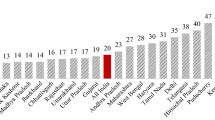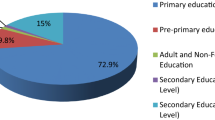Abstract
Globally, about 175 million children have no access to universal education in 2017. Nearly, 16 million young children in East Asia and Pacific Region are not enrolled into school, accounting for 19% of children in pre- and primary school age. This paper analyses surveillance data, extracted from the integrated Health and Demographic Surveillance System (iHDSS) database, developed by Papua New Guinea Institute of Medical Research in the period 2011–2017 to assess the implementation of Millennium Development Goals associated with universal education in Papua New Guinea (PNG). Net enrolment rate in primary education was 58%. Only 28% of children aged 7 were enrolled in Grade 1, and only 7% of children aged 15 years reached Grade 8 in the school year 2015. Late enrolment into Grade 1 among children aged 7 years was identified as the main cause of low net enrolment rate, leading to low completion rate of primary education in the following years and affecting the overall quality of universal education. Despite the improvement in gender equality, males had better access to education services than females as reflected in high male-to-female student ratios among the schooling age population, 5–24 years, which increased from 108 at primary to 132 at secondary and 181 at tertiary education. Educational policy-makers and practitioners should take immediate actions to improve net enrolment in Grade 1 and completion rate at primary education, as well as gender equality in education in PNG.




Similar content being viewed by others
References
ADB, UN ESCAP and UNDP (2012–2013). Asia-Pacific Aspirations: Perspectives for a Post-2015 Development Agenda.
Asia-Pacific Development Effectiveness Facility. (2014). Asia-Pacific Effective Development Co-operation Report 2014, UNDP Asia-Pacific Regional Centre.
Cassity, E. (2010). New partnerships and education policy in Asia and the Pacific. International Journal of Educational Development,30, 508–517.
Crossley, M., & Sprague, T. (2014). Education for sustainable development: Implications for small island developing states. International Journal of Educational Development,35, 86–95.
Department of Education. (2016). National Education Plan 2015–2019: Quality learning for all. Port Moresby: Department of Education, PNG Government.
Department of National Planning and Monitoring. (2009). Millenium Development Goals National Progress Summary Report of Papua New Guinea 2009. Retrieved 22 June, 2018, from https://catalogue.nla.gov.au/Record/5159878.
Faul, M. V. (2014). Future-perfect/present-imperfect: Contemporary global constraints on the implementation of a post-2015 education agenda. International Journal of Educational Development,39, 12–22.
Gakidou, E., Cowling, K., Lozano, R., & Murray, C. J. L. (2010). Increased educational attainment and its effect on child mortality in 175 countries between 1970 and 2009: A systematic analysis. Lancet,376, 959–974.
Global Steering Committee: SDG4/Education. (2018). Regional perspective on education 2030: Asian-Pacific Region. Paris: UNESCO.
Inter-Agency and Expert Group on SDG Indicators (2017). Revised List of Global Suatainalbe Developmetn Goal Indicators.
Kamanda, M., & Sankoh, O. (2015). A systematic review of the status of children’s school access in low- and middle-income countries between 1998 and 2013: Using the INDEPTH Network platform to fill the research gaps. Global Health Action,8, 28430.
Kant, S., Misra, P., Gupta, S., Goswami, K., Krishnan, A., Nongkynrih, B., et al. (2013). The Ballabgarh health and demographic surveillance system (CRHSP-AIIMS). International Journal of Epidemiology,42(3), 758–768.
McCormick, A. (2014). Who are the custodians of Pacific ‘post-2015’ education futures? Policy discourses, education for all and the millennium development goals. International Journal of Educational Development,39, 173–182.
National Executive Council. (2009). Achieving universal education for a better future: Universal Basic Education Plan 2010–2019. Retrieved 22 July, 2015, from http://www.education.gov.pg/quicklinks/documents/ube-plan-2010-2019.pdf.
National Statistics Office. (2012). Primary figures: Papua New Guinea Census 2011, from https://www.nso.gov.pg/index.php/document-library?view=download&fileId=65. Accessed 12 Nov 2019.
Pham, N. B., Pomat, W., & Siba, P. (2017). Comprehensive health and epidemiological surveillance system (CHESS): A new generation of population surveillance for sustainable development of PNG. PNG Medical Journal,60(3–4), 154–172.
PNG Government. (2004). Achieving a better future: A National Plan for Education 2005–2014. Retrieved 30 April, 2016, from http://planipolis.iiep.unesco.org/sites/planipolis/files/ressources/papua_new_guinea_education_plan_2005-2014.pdf.
PNG Government. (2010). Millennium Development Goals Second National Progress Comprehensive Report for Papua New Guinea 2010. Retrieved 22 June, 2018, from http://www.planning.gov.pg/.
PNG Government and The United Nations. (2015). Summary Report for Papua New Guinea: Millennium Development Goals 2015 from http://www.planning.gov.pg/images/dnpm/pdf/MDG-Summary-Report-2015_Opt.pdf. Accessed 12 Nov 2019.
PNG Institute of Medical Research. (2015). Partnership in Health Project: March 2015 Report (Reporting period July–December 2014). Retrieved 15 September, 2015, from https://www.researchgate.net/publication/280804337_PNG_IMR_PiHP_2015_March_Report.
PNG Institute of Medical Research. (2016). Partnership in Health Project Report: Women’s Health (Reporting period July–December 2015). Retrieved 17 April 2017, from http://www.pngimr.org.pg/research%20publications/PNG%20IMR%20PiHP%20March%202016%20Report_%20Women%20Health_FINAL%20approval.pdf.
PNG Institute of Medical Research. (2017). Partnership in Health Project Report: Men’s Health Associated Factors (Reporting period July–December 2016) (unpublished report). Retrieved 23 June 2018, from http://www.pngimr.org.pg/assets/PNG%20IMR%20PIHP%20March%202017%20Report_final%20submision%20EM_02112017.pdf.
PNG Institute of Medical Research. (2019). Comprehensive Health and Epidemiological Surveillance System: Techincal Report on Child’s Health Goroka, Papua New Guinea Institute of Medical Research.
Tarabini, A. (2010). Education and poverty in the global development agenda: Emergence, evolution and consolidation. International Journal of Educational Development,30, 204–212.
Tarabini, A., & Jacovkis, J. (2012). The poverty reduction strategy papers: An analysis of a hegemonic link between education and poverty. International Journal of Educational Development,32, 507–516.
The Pacific Islands Forum Secretariat. (2015). 2015 Pacific Regional MDGs Report.
The United Nations. (2000). Millennium development goals declaration. Retrieved 08 June, 2018, from http://mdgs.un.org.
Tran, L. N., Bauze, A., Nguyen, K. H., Firth, S., & Soto, E. J. (2010). Under-five mortality analysis for Papua New Guinea: Investment case MDGs 4 and 5 (unpublished). Retrieved 22 June, 2018, from https://espace.library.uq.edu.au/view/UQ:302693.
UNESCO. (2015). Pacific education for all 2015 review. Paris: Paris United Nations Educational, Scientific and Cultural Organization.
UNICEF. (2019). A world ready to learn: Prioritizing quality early childhood education. I. 978-92-806-5007-5. New York, UNICEF.
UNICEF and GSO. (2012). Monitoring the situation of children and women: Multiple Indicator Cluster Survey 2011 from: http://www.un.org.vn/en/publications/doc_details/296-multiple-indicator-cluster-survey-2011.html. Accessed 12 Nov 2019.
United Nations. (2017). Gender, the environment and sustainable development in Asia and the Pacific. S. N. E.17.II.F.18. Bangkok, Economic and Social Commission for Asia and the Pacific.
WHO West Pacific Region. (2014). Achieving the health-related Millennium Development Goals in the Western Pacific Region.
World Bank and United Nations. (2013). Papua New Guinea: 2011–2012 Country Gender Assessment. Retrieved 30 April, 2015, from https://www.adb.org/sites/default/files/institutional-document/33859/files/cga-png-2011-2012.pdf.
World Bank. (2010). PNG 2009-2010 Household Income and Expenditure Survey, from https://www.nso.gov.pg/index.php/projects/householdincome-expenditure-survey. Accesssed 12 Nov 2019.
World Bank. (2018). Growing smarter: Learning and equitable development in East Asia and Pacific. World Bank East Asia and Pacific Regional Report. Washington, DC: World Bank.
Author information
Authors and Affiliations
Corresponding author
Additional information
Publisher's Note
Springer Nature remains neutral with regard to jurisdictional claims in published maps and institutional affiliations.
Rights and permissions
About this article
Cite this article
Pham, N.B., Okely, A.D., Whittaker, M. et al. Millennium development goals in Papua New Guinea: towards universal education. Educ Res Policy Prac 19, 181–209 (2020). https://doi.org/10.1007/s10671-019-09255-4
Received:
Accepted:
Published:
Issue Date:
DOI: https://doi.org/10.1007/s10671-019-09255-4




